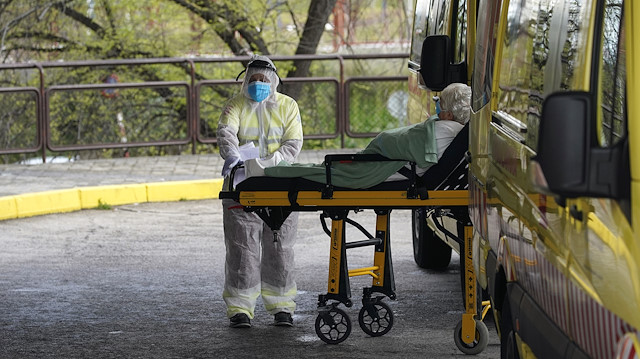

A medical worker pushes a stretcher with a patient next to the ambulances
In total, 223,759 have tested positive for coronavirus, while more than 22,900 people died so far
Spain registered another 378 deaths on Saturday, bringing the country’s total death toll to 22,902, according to the Spanish Health Ministry.
Saturday marked the second day in a row that the country reported less than 400 daily COVID-19 deaths -- something which has not happened since mid-March.
It is also the second consecutive day that the country has registered more recoveries -- 3,353 -- than new active infections -- 2,944.
In total, 223,759 people contracted the disease and more than 95,700 people have recovered.
Trends observed over the recent days and weeks indicate that Spain has overcome the peak of this first coronavirus wave. The question now is how to ease measures responsibly.
Spain’s lockdown is set to continue through May 9, but today is the last day that many children will be confined to their homes.
Since March 14, children have had virtually no excuse to go outside. While adults are forbidden from exercising outdoors, they have been allowed to go to supermarkets, pharmacies or essential jobs since the beginning of the lockdown.
On the advice of child care experts and after the pleas of frustrated children and parents, the government decided that people under 14 years of age will be able to go outside for an hour each day beginning on Sunday.
“Controlled outings for the young population could bring benefits associated with a healthy lifestyle… like improving sleep quality, vitamin D synthesis and improved social and familiar wellbeing,” said a government statement on Saturday.
Today, the Spanish government officially decreed the new rules. Children will only be allowed to venture a maximum of one kilometer from home at 9 a.m.- 9 p.m. local time, and under the supervision of an adult at all times.
Playgrounds will remain off-limits, and children must maintain social distance with any third parties. Children in quarantine or with COVID-19 symptoms must stay home.
After May 9, the de-escalation will be “slow” and “gradual,” according to Prime Minister Pedro Sanchez. The easing of measures is also expected to vary by geographic area – Madrid, one of the worst-hit regions, may have to wait longer than rural areas or regions with fewer cases.
After originating in China last December, COVID-19 has spread to at least 185 countries and regions. Europe and the U.S. are currently the worst-hit regions.
The pandemic has killed over 197,500 people, with total infections exceeding 2.82 million, while more than 796,300 have recovered, according to figures compiled by the U.S.-based Johns Hopkins University.
#Coronavirus
#COVID-19
#Europe
#pandemic
#Spain

